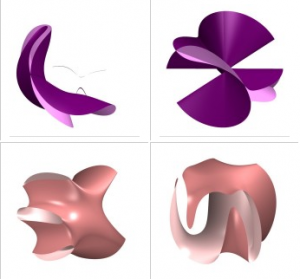
London: Mathematicians have embarked on a three-year project to create their own version of the periodic table that will provide a vast directory of all the possible shapes in the universe across three, four and five dimensions.
Linking shapes together in the same way as the periodic table links groups of chemical elements, the new table should provide a resource that mathematicians, physicists and other scientists can use for calculations and research in a range of areas, including computer vision, number theory, and theoretical physics.
"The periodic table is one of the most important tools in chemistry. Our work aims to create a directory that lists all the geometric building blocks and breaks down each one's properties using relatively simple equations," said project leader Alessio Corti, from the Department of Mathematics at Imperial College London.
Describing the 'flow' of building blocks
The researchers, from Imperial College London, the Computational Algebra Group at the University of Sydney and institutions in Japan and Russia, are aiming to identify all the shapes across three, four and five dimensions that cannot be divided into other shapes.
Through differential equations - a type of mathematical equation that expresses a relationship between functions and their derivatives - the building block shapes are able to be described in terms of their 'flow'.
Italian mathematician, Gino Fano, used a technique during the 1930's to find nine two-dimensional atomic shapes. The current approach, invented by Corti and his colleague Vasily Golyshev, is based on ideas from string theory to find atomic shapes in higher dimensions.
"We are searching for special shapes, called Fano varieties, that are the 'elements' in our 'periodic table of shapes'," said the team on their blog.
Exploring other dimensions
Corti's team will be analysing shapes that involve dimensions that cannot be 'seen' in a conventional sense in the physical world.
In addition to the three dimensions of length, width and depth found in a three-dimensional shape, the scientists will explore shapes that involve other dimensions.
For example, the space-time described by Einstein's Theory of Relativity has four dimensions - the three spatial dimensions, plus time. String theorists believe that the Universe is made up of many additional hidden dimensions that cannot be seen.
Solving problems with Magma
Corti's colleague on the project Tom Coates, also from the Imperial College London, has created a computer modelling program that should enable the researchers to pinpoint the basic building blocks for these multi-dimensional shapes from a pool of hundreds of millions of shapes.
The researchers will be using this program to identify shapes that can be defined by algebraic equations and that cannot be divided any further. They do not yet know how many such shapes there might be.
The contributors from the Computational Algebra Group in Sydney lead by John Cannon have also developed very powerful piece of mathematical software called Magma to assist in the discovery of Fano varieties, said Coates.
"Magma is a very flexible piece of software which will solve many mathematical problems, but the Computational Algebra Group have added extra features to Magma to help with our search for Fano varieties and have fine-tuned their software to make our search more efficient."
Useful for robotics and physics
The researchers calculate that there are around 500 million shapes that can be defined algebraically in four dimensions and they anticipate that they will find a few thousand building blocks from which all these shapes are made.
"We think we may find vast numbers of these shapes, so you probably won't be able to stick our table on your wall, but we expect it to be a very useful tool," said Corti.
Coates added: "Understanding these kinds of shapes is really important for lots of aspects of science. If you are working in robotics, you might need to work out the equation for a five dimensional shape in order to figure out how to instruct a robot to look at an object and then move its arm to pick that object up."
"If you are a physicist, you might need to analyse the shapes of hidden dimensions in the Universe in order to understand how sub-atomic particles work. We think the work that we're doing in our new project will ultimately help our colleagues in many different branches of science."
"In our project we are looking for the basic building blocks of shapes. The next challenge is to understand how properties of the larger shapes depend on the 'atoms' that they are made from. In other words, we want to build a theory of chemistry for shapes," said Coates.



Reader Comments
to our Newsletter